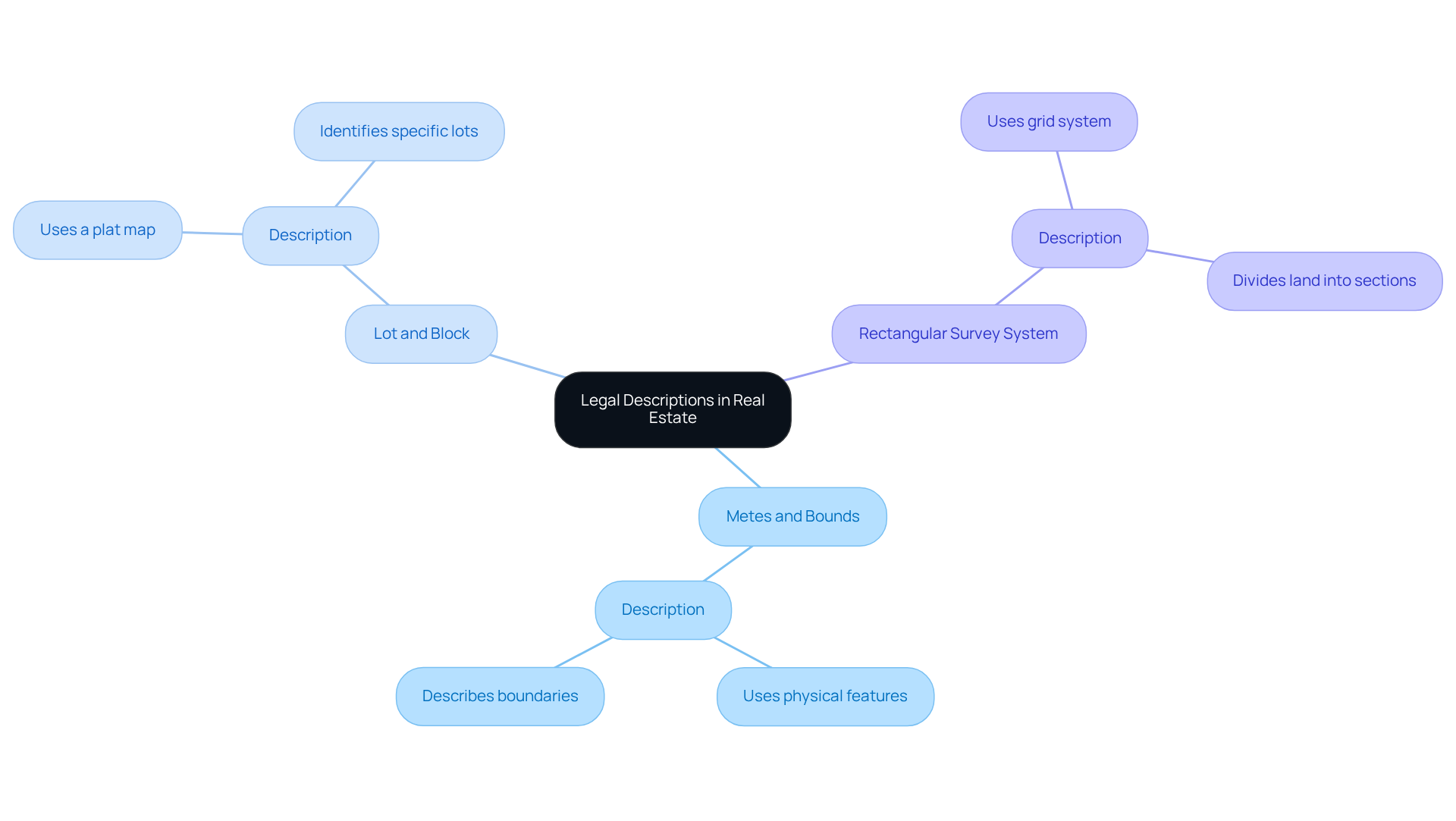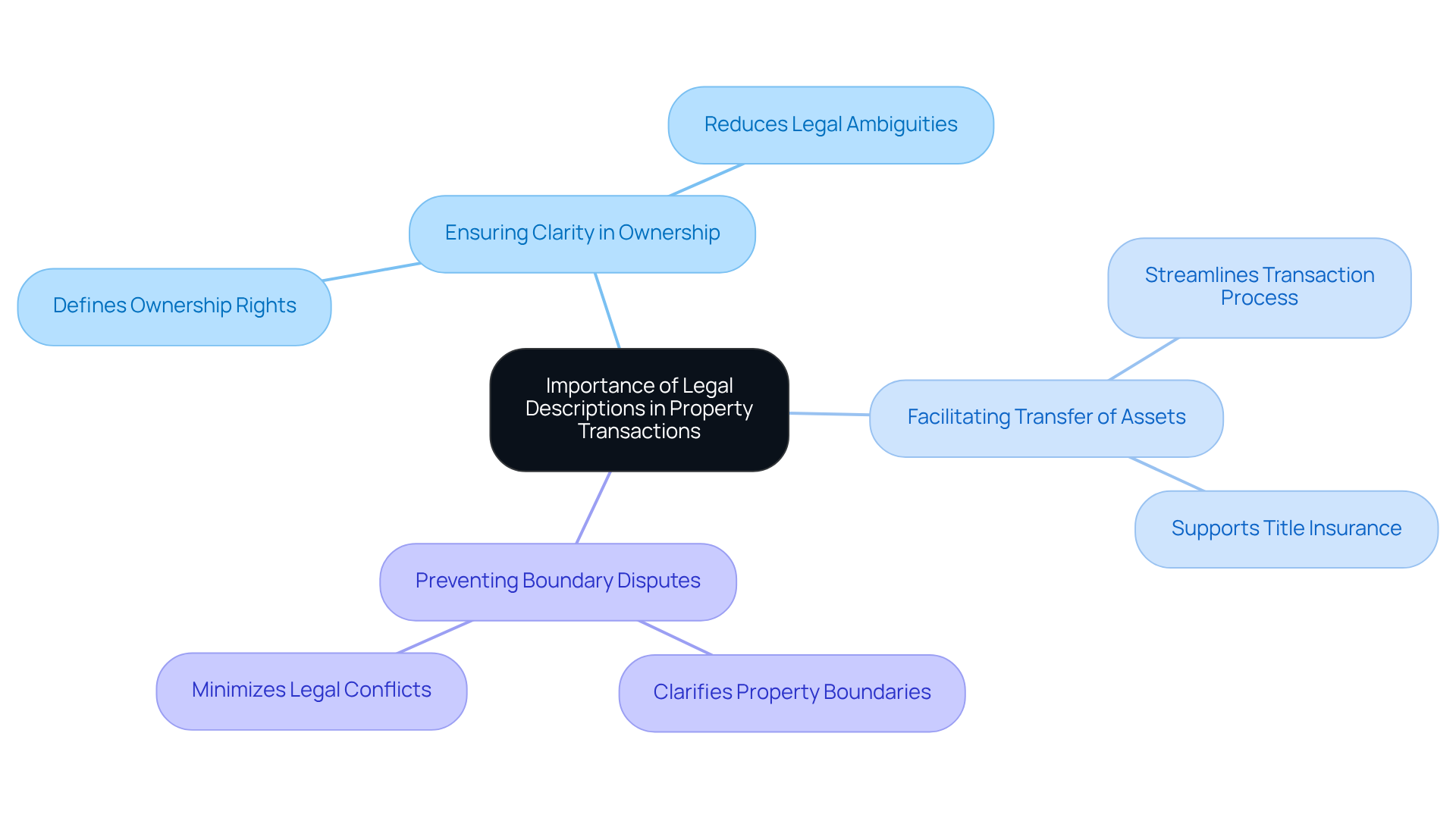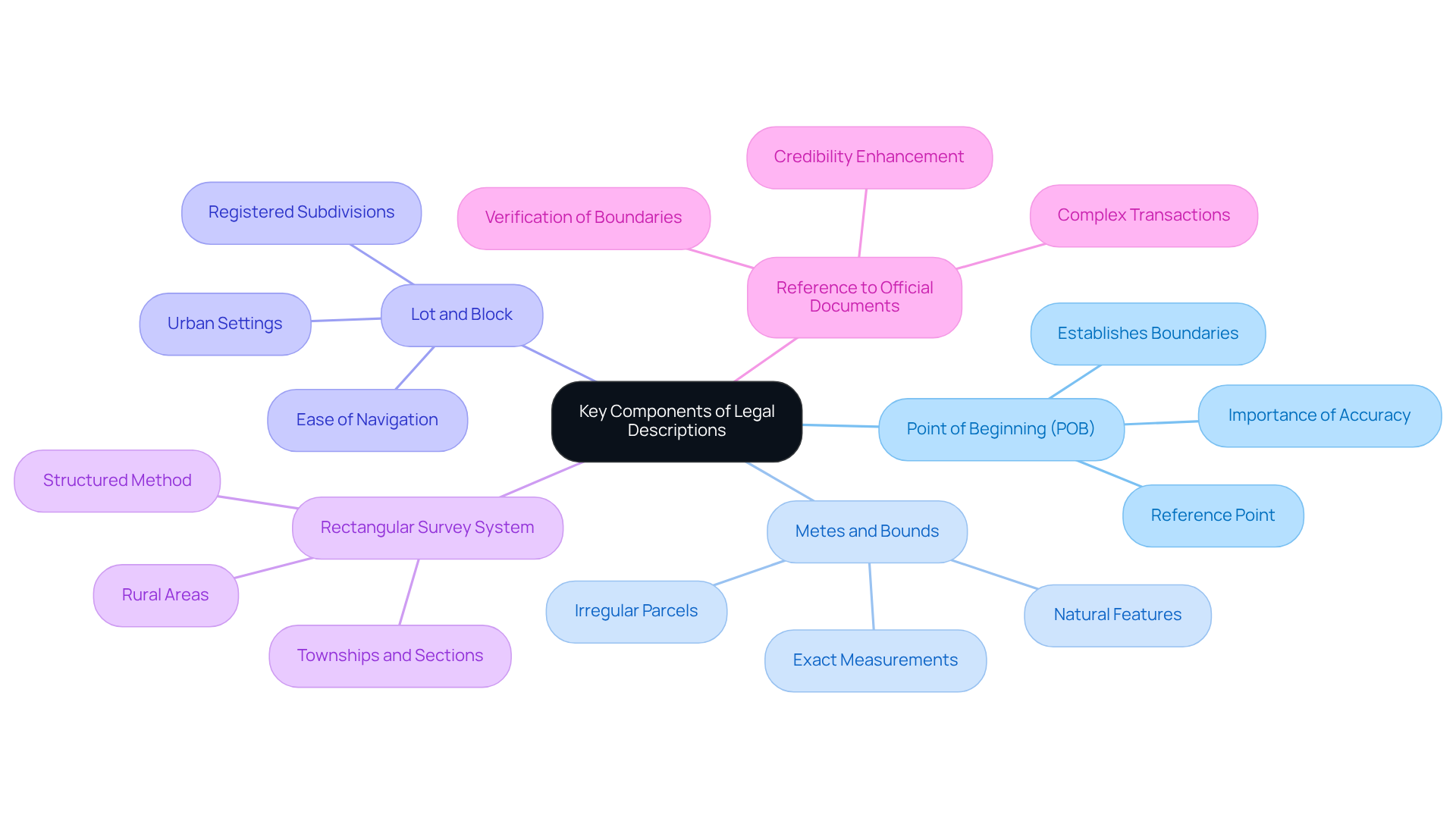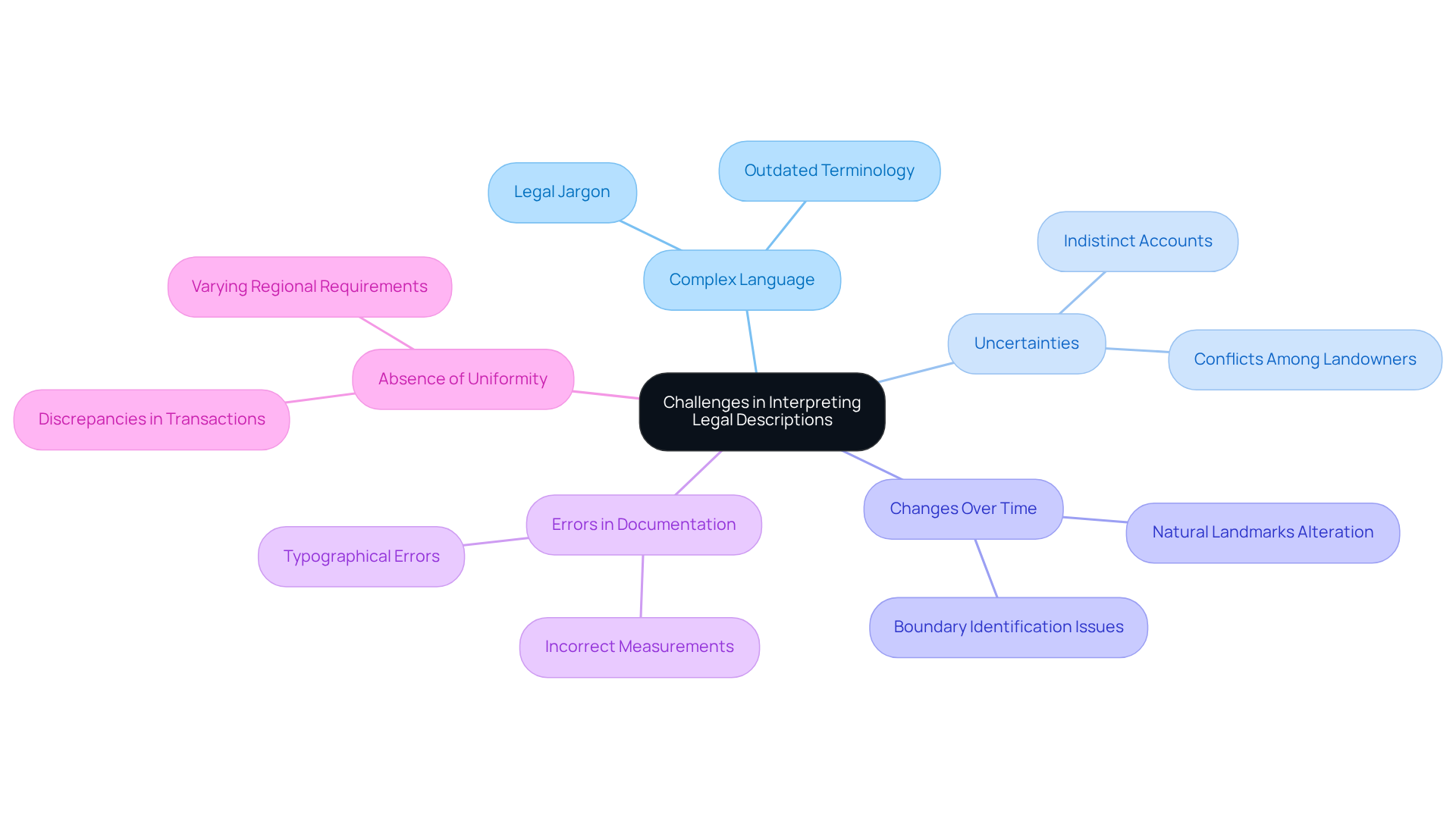Overview
The article emphasizes the critical components and challenges associated with property legal descriptions, underscoring their significance in real estate transactions. Accurate legal descriptions are essential for establishing ownership and preventing disputes. Furthermore, it addresses the challenges posed by complex language, ambiguities, and documentation errors, which can complicate property identification and transactions. Understanding these challenges is crucial for navigating the complexities of real estate effectively.
Introduction
Understanding property legal descriptions is essential for anyone navigating the complex world of real estate. These formal statements serve as the backbone for identifying land parcels, outlining critical information such as boundaries and dimensions that are vital for ownership clarity and transaction success.
However, the intricacies of legal jargon and the potential for misinterpretation create significant challenges for buyers, sellers, and real estate professionals alike.
How can one effectively decode these descriptions to avoid costly disputes and ensure smooth transactions?
Define Legal Descriptions in Real Estate
A formal, precise statement in real estate serves as a crucial method for identifying a specific parcel of land. This statement typically encompasses essential information such as the land's boundaries, dimensions, and location, which are often detailed in official documents like deeds and leases, contributing to understanding .
Legal definitions can be categorized into three primary types:
- Metes and bounds
- Lot and block
- Rectangular survey system
Each method is designed to ensure understanding property legal descriptions for a clear and unambiguous identification of the asset, which is vital for legal purposes and transactions.

Explain the Importance of Legal Descriptions in Property Transactions
In real estate transactions, understanding property legal descriptions is essential, as it provides the critical information needed to identify the exact location and boundaries of a parcel. They fulfill several important functions:
- Ensuring clarity in ownership
- Facilitating the transfer of assets
- Preventing boundary disputes
A precise official outline is vital for title insurance policies, as it clearly defines the asset being insured. Understanding property legal descriptions is essential, as without an accurate formal depiction, transactions can lead to , including disputes over property boundaries and ownership claims, which can be costly and time-consuming to resolve.

Identify Key Components of Legal Descriptions
Key components of legal descriptions typically include:
- Point of Beginning (POB): The POB serves as the fundamental reference point for legal specifications, often marked by a physical landmark or precise coordinates. Its accuracy is paramount, as it establishes the initial location from which all land boundaries are measured.
- Metes and Bounds: This traditional method delineates land boundaries through natural features and exact measurements, providing a comprehensive perimeter description. It is particularly advantageous for irregularly shaped parcels.
- Lot and Block: Commonly utilized in urban settings, this technique identifies a specific lot within a registered subdivision or plat map, facilitating easier navigation and understanding of location details.
- Rectangular Survey System: This systematic approach segments land into townships and sections, offering a structured method to describe larger parcels. It is frequently employed in rural areas and aids in standardizing real estate descriptions.
- Reference to Official Documents: Legal descriptions often reference official surveys or maps, enhancing the credibility and verification of land boundaries. This practice is increasingly vital as real estate transactions grow more complex.
Understanding is essential for accurate delineation, as it influences the interpretation of boundaries and ownership rights. Current trends in regulatory outlining techniques underscore the integration of technology, such as GIS mapping, to improve accuracy and efficiency in land surveys. For example, a recent project requiring the surveying of three additional tracts totaling over 450 acres illustrates the practical application of these methods. As the real estate landscape evolves, the significance of the POB remains a critical element in ensuring clear and enforceable terms. As highlighted by a field crew member, "This quick turnaround is a testament to our field crew’s dedication, determination, and skill," emphasizing the importance of efficiency in property surveying.

Discuss Challenges in Interpreting Legal Descriptions
Understanding property legal descriptions presents significant challenges, which Parse AI aims to address through its .
- Complex Language: Legal jargon and outdated terminology often render explanations difficult for those untrained in real estate law. Parse AI's machine learning capabilities clarify these complexities, making them more accessible to a broader audience.
- Uncertainties: Indistinct or insufficient accounts can lead to misunderstandings regarding land limits, resulting in conflicts among adjacent landowners. By swiftly extracting essential information from title documents, Parse AI effectively mitigates the risk of such ambiguities.
- Changes Over Time: Natural landmarks referenced in previous accounts may have changed or disappeared, complicating the identification of property boundaries. Parse AI's advanced technology aids in accurately identifying current limits.
- Errors in Documentation: Mistakes in official details—such as typographical errors or incorrect measurements—can lead to significant issues, including boundary disputes and title defects. Parse AI's precision in data extraction minimizes these errors, enhancing the reliability of official documents.
- Absence of Uniformity: Different regions may have varying requirements for official narratives, resulting in discrepancies that complicate real estate transactions. Parse AI's adaptability allows it to meet diverse regulatory standards, simplifying the process for title researchers.
These factors highlight the critical importance of understanding property legal descriptions in real estate, as they are essential for confirming property ownership and preventing disputes. By harnessing Parse AI's technology, real estate professionals can navigate these challenges more efficiently, ultimately saving time and reducing costs.

Conclusion
Understanding property legal descriptions is fundamental for anyone involved in real estate transactions. These descriptions not only identify specific parcels of land but also play a crucial role in ensuring clarity in ownership and preventing disputes. By accurately detailing boundaries, dimensions, and locations, legal descriptions serve as the backbone of property transactions, safeguarding both buyers and sellers against potential complications.
Throughout the article, several key components of legal descriptions were explored, including various methods such as:
- Metes and bounds
- Lot and block
- Rectangular survey system
Each method provides distinct advantages, particularly in terms of clarity and precision. Furthermore, the challenges inherent in interpreting these descriptions—ranging from complex legal language to errors in documentation—highlight the necessity for accurate understanding to avoid costly disputes and misunderstandings.
As the real estate landscape continues to evolve, leveraging innovative technology like Parse AI can significantly enhance the accuracy and efficiency of property legal descriptions. Emphasizing the importance of precise legal descriptions not only aids in smooth transactions but also fosters trust and confidence among stakeholders. Engaging with these concepts is essential for real estate professionals and property owners alike, ensuring they navigate the complexities of property transactions with clarity and assurance.
Frequently Asked Questions
What is a legal description in real estate?
A legal description is a formal, precise statement used to identify a specific parcel of land, detailing essential information such as boundaries, dimensions, and location.
Why are legal descriptions important?
Legal descriptions are crucial for understanding property boundaries and are necessary for legal purposes and transactions involving real estate.
What are the main types of legal descriptions in real estate?
The main types of legal descriptions are metes and bounds, lot and block, and rectangular survey system.
How do legal descriptions contribute to property identification?
Legal descriptions provide a clear and unambiguous identification of a property, ensuring that all parties involved have a mutual understanding of the asset in question.




